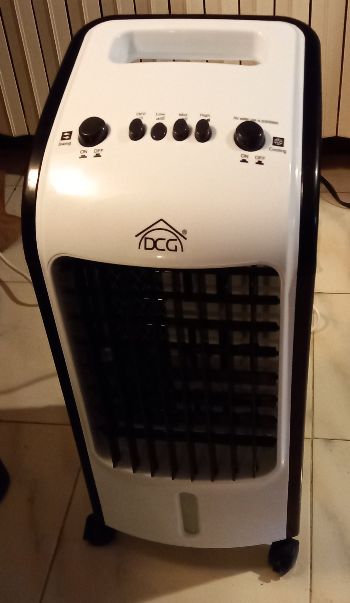
Right now, the thermometer outside our house in Italy is hovering around 86 degrees Fahrenheit. For readers in most of the rest of the world, that’s 30 degrees Celsius. That’s pretty damn hot for 7 in the evening. Unseasonably hot. And it’s going to be hot — if not hotter — for at least two more months. We all now know about climate change, whether one believes it’s caused by humans or not.
And yet, inside this room, the temperature is a tolerable 74 degrees. No, this is not some centuries-old trick, invented by the Romans or the Etruscans before them. Nor is it some clever manipulation of traditional shutters and windows to maximize the capture of breezes. Indeed, we already do that, but with a marginal effect on the temperature.
No. This is a bit of modern technology, available in our stores locally and of course via the globally ubiquitous Amazon. I’m talking about Water Fans. One thing that Western Washington has in common with Central Italy is that domestic air conditioning is not typical. Until recently it hasn’t been needed in either place, save for a few weeks in summer. Here, the cost of power is high, another factor that makes AC in the home a luxury.
Now, when I have mentioned water fans to a few friends from the American Southwest, they immediately ask if I mean misters – those devices found in restaurants from Phoenix to Austin to New Orleans. Nope, not misters. I suspect we have walked by a grouping of water fans multiple times in stores, thinking that they were simply more upscale fans with upscale price tags.
Almost by accident we passed one that was operating. Simultaneously, we exclaimed “Wait! What IS that?” Markedly cool air wafted around our legs and torsos. We lingered, puzzled and relishing the coolness. Is it a small room air conditioner? We already knew about those. They can cost hundreds, some many hundreds. They also require exhaust tubes to snake through windows. They are big, ungainly, and take up a lot of space in a room. And consume a lot of power. We have stayed away from them, for all those reasons.
But these appliances were small and comparatively compact. They draw the same wattage as a regular fan. The one near me right now is barely bigger than a microwave oven, if placed on its end. We bought two others, each the size of a regular room fan mounted on a stand, but more portly in profile. I will shortly explain.
The water fans work on the scientific principle known as “wet bulb” temperature. If you introduce water to blowing air, the temperature can drop by 10-15 degrees. The machines have containers at their wide base that get filled with water. Some even come with packs that you can freeze and add to the container for even greater effect. I simply use tap water.
The machine circulates the water upward into a scrim through which air is directed. There are low, medium, and high settings on the face. I mainly use the low setting. The unit also allows for a rotating motion if desired. This model is basic, and others have more sophisticated controls and options and some have remote controllers.
One morning the room got so cool that I had to throw a light cover on – in July. Normally, the device simply makes the ambient temperature tolerable enough to work or to sleep without feeling sweaty.
To be fair, not everyone thinks water fans are the minor miracle that we do. There are some reviews on-line that complain about them not working as advertised. A friend with the same make and model as mine complained to me that it leaked water and never put out cool air. I suggested to her that it was probably defective and that she should take it back. Some brands might be problematic. Reading reviews can help but sometimes they aren’t reliable either. Also, some buyers’ expectations might be too high. After all, this is not air conditioning as we know it.
The only nuisance I can fuss about is that the container only holds about six hours’ worth of water. Then the machine starts to make an audible gurgling sound, not unlike when you get to the bottom of a milkshake. That wakes me up. But then, I often just turn it off in the less hot hours of the morning. I also keep a pitcher of water nearby in case I want to extend the coolness.
I had never heard of water fans until a month ago. We took a chance on them and they have made a huge difference during this period of oppressive heat.
Of course, far better would be taking global measures to diminish global warming. But then, this is not a column of political advice.

Also known as evaporative “swamp cooler”.
https://www.energy.gov/energysaver/evaporative-coolers
Of course, they work the best when the air is dry. Today’s forecast here in north Seattle peaks at 90°, with relative humidity 49%, dewpoint 67°. Not the sauna you’d get in some parts of the country, but neither is it what anyone would call dry, so results will be modest, and raising the indoors humidity wouldn’t be at all desirable. I’m only guessing, but it looks to me like something you’d best use very locally in the vicinity of your desk or whatever, with windows open to pull in drier air.
https://www.hunker.com/13401280/effective-dewpoint-range-for-evaporative-coolers
When we had the wildfires and the windows closed, our “swamp cooler” kept our bedroom bearable without AC. To each their own, but I think Mark’s right on that these are a good solution without having to spend big money on portable AC units and associated hassle.